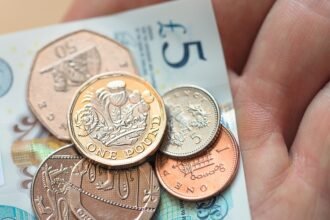- GBP/USD continues to edge higher after posting strong gains on Thursday.
- The pair could face next technical resistance at 1.2780.
- Improving risk mood could help the pair extend its recovery heading into the weekend.
After falling to its weakest level since early July below 1.2700 on Thursday, GBP/USD gained traction and closed the day in positive territory. The pair preserves its recovery momentum and continues to stretch higher toward 1.2800 in the European session on Friday.
British Pound PRICE Today
The table below shows the percentage change of British Pound (GBP) against listed major currencies today. British Pound was the strongest against the Australian Dollar.
| USD | EUR | GBP | JPY | CAD | AUD | NZD | CHF | |
|---|---|---|---|---|---|---|---|---|
| USD | -0.03% | -0.15% | -0.07% | 0.02% | 0.07% | -0.12% | -0.15% | |
| EUR | 0.03% | -0.09% | 0.03% | 0.07% | 0.11% | -0.09% | -0.11% | |
| GBP | 0.15% | 0.09% | 0.11% | 0.14% | 0.21% | 0.00% | 0.00% | |
| JPY | 0.07% | -0.03% | -0.11% | 0.04% | 0.11% | -0.10% | -0.08% | |
| CAD | -0.02% | -0.07% | -0.14% | -0.04% | 0.04% | -0.15% | -0.14% | |
| AUD | -0.07% | -0.11% | -0.21% | -0.11% | -0.04% | -0.20% | -0.20% | |
| NZD | 0.12% | 0.09% | 0.00% | 0.10% | 0.15% | 0.20% | 0.00% | |
| CHF | 0.15% | 0.11% | -0.01% | 0.08% | 0.14% | 0.20% | -0.00% |
The heat map shows percentage changes of major currencies against each other. The base currency is picked from the left column, while the quote currency is picked from the top row. For example, if you pick the British Pound from the left column and move along the horizontal line to the US Dollar, the percentage change displayed in the box will represent GBP (base)/USD (quote).
The US Department of Labor reported on Thursday that the number of first-time applications for unemployment benefits dropped to 233,000 in the week ending August 3 from 250,000 in the previous week. The immediate market reaction to this data helped the US Dollar (USD) gather strength and dragged GBP/USD lower.
Later in the session, the USD lost its footing as risk flows started to dominate the action in financial markets. Reflecting the upbeat mood, Wall Street’s main indexes registered impressive gains, with the Nasdaq Composite leading the rally with a 3% upsurge.
At the time of press, US stock index futures were up between 0.2% and 0.6% on the day. In case the mood remains upbeat in the American session on Friday, the USD could struggle to find demand and allow GBP/USD to extend its recovery.
On the other hand, investors could look to move to the sidelines in case they see a possibility of geopolitical tensions escalating again over the weekend. In this scenario, week-end flows could cause GBP/USD to lose its traction.
GBP/USD Technical Analysis
GBP/USD broke above the descending trend line and the Relative Strength Index (RSI) indicator on the 4-hour chart rose toward 60, reflecting a bullish tilt in the short term outlook.
On the upside, 1.2780 (Fibonacci 61.8% retracement of the latest uptrend) aligns as first resistance before 1.2810 (200-period Simple Moving Average (SMA)) and 1.2830-1.2835 (Fibonacci 50% retracement, 100-period SMA).
Supports could be seen at 1.2710 (Fibonacci 61.8% retracement), 1.2670 (static level) and 1.2620 (static level, beginning point of the latest uptrend).
Pound Sterling FAQs
The Pound Sterling (GBP) is the oldest currency in the world (886 AD) and the official currency of the United Kingdom. It is the fourth most traded unit for foreign exchange (FX) in the world, accounting for 12% of all transactions, averaging $630 billion a day, according to 2022 data. Its key trading pairs are GBP/USD, aka ‘Cable’, which accounts for 11% of FX, GBP/JPY, or the ‘Dragon’ as it is known by traders (3%), and EUR/GBP (2%). The Pound Sterling is issued by the Bank of England (BoE).
The single most important factor influencing the value of the Pound Sterling is monetary policy decided by the Bank of England. The BoE bases its decisions on whether it has achieved its primary goal of “price stability” – a steady inflation rate of around 2%. Its primary tool for achieving this is the adjustment of interest rates. When inflation is too high, the BoE will try to rein it in by raising interest rates, making it more expensive for people and businesses to access credit. This is generally positive for GBP, as higher interest rates make the UK a more attractive place for global investors to park their money. When inflation falls too low it is a sign economic growth is slowing. In this scenario, the BoE will consider lowering interest rates to cheapen credit so businesses will borrow more to invest in growth-generating projects.
Data releases gauge the health of the economy and can impact the value of the Pound Sterling. Indicators such as GDP, Manufacturing and Services PMIs, and employment can all influence the direction of the GBP. A strong economy is good for Sterling. Not only does it attract more foreign investment but it may encourage the BoE to put up interest rates, which will directly strengthen GBP. Otherwise, if economic data is weak, the Pound Sterling is likely to fall.
Another significant data release for the Pound Sterling is the Trade Balance. This indicator measures the difference between what a country earns from its exports and what it spends on imports over a given period. If a country produces highly sought-after exports, its currency will benefit purely from the extra demand created from foreign buyers seeking to purchase these goods. Therefore, a positive net Trade Balance strengthens a currency and vice versa for a negative balance.






















